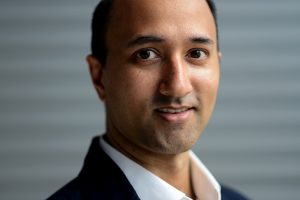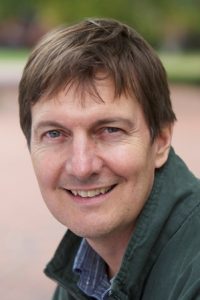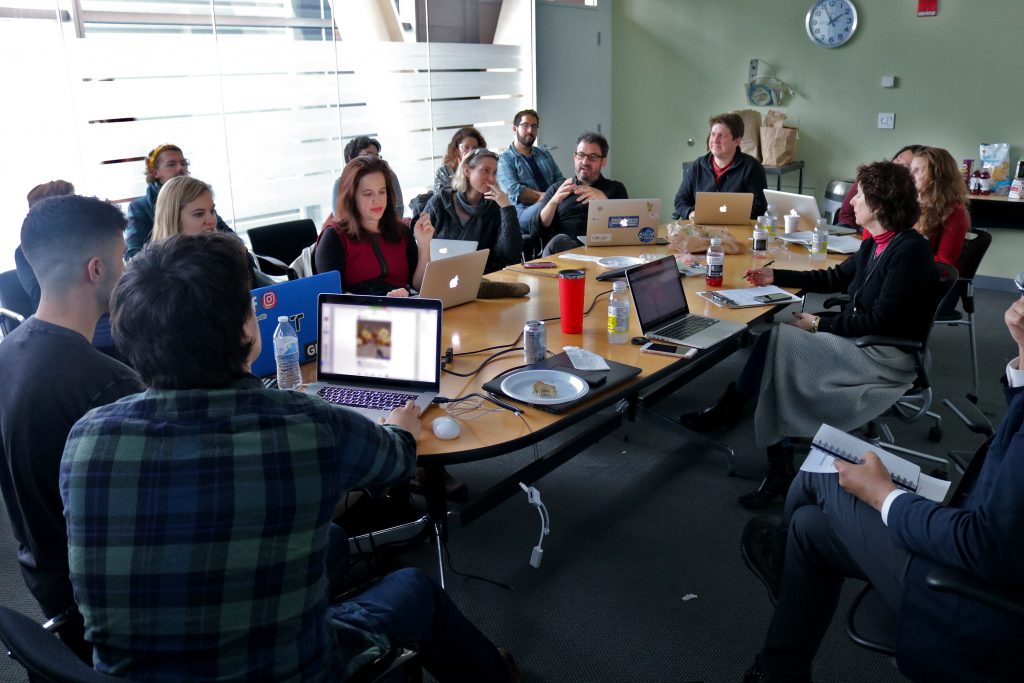
Stories
Putting Connection First
A conversation with WGBH’s John Bredar and Adnaan Wasey about the power of storytelling, reaching new audiences, and the creation of the Civic Science Fellows program
Over the past few months, we have been deeply engaged with partners in designing a new effort to build capacity for meaningful connections between science, society, and communities, working toward a future in which our society places science at the heart of shaping decisions. The Civic Science Fellowship will foster collaboration among scientists, community members, media producers, educators, funders, and others to advance inclusive engagement with science and its social implications.
The conversation below dives into the beginning of the story and starts to look to its future. The inspiration for the Civic Science Fellowship comes from a pilot we built with WGBH, one of the country’s leading public media organizations and the creators of award-winning science media—including NOVA, the most-watched prime-time science series on American television.
Here, I speak with John Bredar, WGBH’s Vice President for National Programming, about the origins of the pilot fellowship we created, as well as Adnaan Wasey, the innovative media producer who became the first Rita Allen Science Communication Fellow and now will be among the first Civic Science Fellows. John and Adnaan reflect on what they are learning from working together to reach new audiences, the original content studio Adnaan established at WGBH, how Civic Science Fellows can help change cultural ideas about science, and the human instincts that draw us again and again to stories.
—Elizabeth Good Christopherson
President and Chief Executive Officer
Rita Allen Foundation
What brought you to your work in civic science?

Adnaan Wasey (Photo: Meredith Nierman/WGBH)
ADNAAN: Most of my career has been in journalism, independent film, and digital media, so I come to my work from the perspective of storytelling and platforms. I see the potential for storytelling to improve understanding around complex issues.
But what kind of storytelling is most effective? Is it scientists communicating their work directly to the public? Or is it news media and documentary films? Those work, but at the same time, we know that our views about scientists and science are formed in large part from mass media entertainment.
If you’re like 81 percent of Americans, you can’t name a living scientist, but you probably have no trouble generating a list of scientists from your favorite television programs and films. But the problem with programs like The Big Bang Theory and Rick & Morty, which are two of the most popular series on television, is that they are not rooted in science. They may effectively propagate negative views about science and society.
We’re also in an era where America is the global leader in science, but where that position is at risk. Sixty eight percent of Americans do not believe in evolution, 43 percent of parents with young children believe MMR vaccines pose at least a medium risk of side effects, 39 percent of Americans think alternative therapies like diet and vitamins alone can cure cancer—there are many examples.
“The reality is, for most people, learning is entangled with their social identities, cultural beliefs, their values, their biases.” –Adnaan Wasey
A couple of years ago, the National Academies of Sciences, Engineering and Medicine released a report, Communicating Science Effectively: A Research Agenda, that noted the decades-old and widening knowledge gap in science, and also essentially called out producers for creating science media only for an easy-to-reach, “elite” audience. So now we have a worthy challenge—how can we create and distribute science entertainment and reach non-elite audiences?

John Bredar (Photo: Becky Hale/NGS)
JOHN: WGBH plays a significant role in communicating science to the American public through NOVA and a variety of science and technology programming—including kids shows, radio programs, and video and social assets. We are also the STEM lead for PBS Learning Media, public media’s education arm. But in spite of what we and so many others have been doing in this space, the statistics Adnaan references about the pervasive lack of understanding about the scientific process and science in general are numbers we can’t afford to ignore.
Science literacy couldn’t be more important for a democracy than it is right now, and this will only continue as we go forward—into a future defined by rapid technological change and the press of climate change. This pulls us even more urgently into issues at the intersection of science and society—civic science. And it gives us a renewed commitment to reach broader audiences with what is exciting and revelatory knowledge about our world.
Adnaan, would you tell us more about your experiments in bringing diverse voices into the conversation about science?
ADNAAN: A few months ago, I started running a studio, called Launchpad, where we’ve been working with creative talent to develop television pilots rooted in entertainment—fiction, comedy, animation. The projects are being made for social media, so they’re short and sometimes interactive too. We’re taking what we’re learning and progressing to creating multiple series. And we’ll continue testing the media to report back on which storytelling devices could have the most potential for impact on issue literacy.
We also think a lot about the power of stories. Do you have a story to share from this work to reach new audiences—maybe something that surprised you?
ADNAAN: When we were starting Launchpad, the participants had the same mindset most media producers would have, which is to think—how do we pack as much educational content into this as we can? It was a revelation for them to hear me say, “Let’s focus on entertaining people first.” And make sure that the science is valid and that scientists are represented well, but if it’s not entertaining, we’re wasting our time. It is a new idea for creators.
That was a real shift for them, and I think it freed them up to do excellent creative work that also achieved the goals we’re trying to reach.
That’s fantastic. Thank you. John, are you going to jump in?
JOHN: When we were at the very end of SMASH ’14 [Science Media Awards and Summit in the Hub], we had this interesting final session. We had asked two producers to essentially report on SMASH and tell us what they had heard from the Symposium. In the final panel they were feeding back observations, and then we put it up to the audience.
At one point, a young African American woman stood up, and she said, “This has been great, but I really don’t see anybody who looks like me here. I wonder if you could do something about that.”
For me, that drove the conversation with you, Elizabeth, that led to the creation of the first SMASH Fellows who, with RAF support, brought 10 diverse scientists and science media makers to the three-day SMASH16 symposium, and eventually to the idea of a year-long, embedded science communication fellow. And of course Adnaan’s entire focus has been reaching new groups and expanding the size of the choir.
For me, that was a really visceral moment, where she had the guts to stand up in this auditorium that was mostly white, and say something that everyone could benefit from. And that has launched many boats.
Those are both terrific stories—they get at some of the “ah-has” and learnings. What else have you learned so far?
ADNAAN: The reason science is divisive is because the truth isn’t persuasive.
There’s an incorrect thought that just presenting information leads to enlightenment. I call this factsplaining, and we know it doesn’t work. The reality is, for most people, learning is entangled with their social identities, cultural beliefs, their values, their biases.
Social scientists know this, so I’ve been analyzing media in the context of decades of research related to advertising and persuasion. I’ve developed a framework for making what I’m calling persuasive entertainment. The research is telling us that it’s possible to increase science literacy among a broad adult population by using some counterintuitive concepts, like humor and fiction, and by delivering simplified content via relatable characters. In short, when people are engrossed by narratives, we can educate them.
More than two-thirds of Americans don’t have a bachelor’s degree. I think there’s a bigger imperative for getting adults from an F to a D than from an A to an A+. The factsplaining can go, and the entertainment part can come forward.
I’m hoping to make it acceptable for media producers to not have to appeal to intellect, which is potentially turning off the populations that haven’t yet been won over. We need to be cognizant about circumventing the social identities that would create immediate barriers, including politics and religion. We don’t want to put anyone in a situation where they have to choose values over facts.
“There is a problem—there is a worthy challenge. And I was excited by that.” –Adnaan Wasey
There are few examples of persuasive entertainment so far, but we know instinctively that TV can influence us. And research is catching up to this idea. For example, The X-Files had perhaps the first realistic portrayal of a scientist in popular TV in Dana Scully. We now know that it had a sizable influence on women pursuing STEM professions—and it was a science-fiction show about alien abductions, the supernatural, and all sorts of monsters.
We’ll be repackaging all of this learning into a form that is accessible to non-technical media producers, with examples and guidance on how to make the best use of the latest research.
What are you most excited about right now?
ADNAAN: Of course, I’m excited to see how audiences react to the series we’re making, but I’m also curious to see how others might apply the concepts of persuasive entertainment for their own work—and not just in science. I don’t believe there’s anything preventing application of this work to other complex issues, such as health, economics, policy, and other subjects that come up in the news. I think our work is of direct interest to the journalistic enterprise and to debunking and countering misinformation.
JOHN: We are taking a new look at all of our national science efforts at WGBH, especially our major science brand, NOVA, and rethinking how we can best marshal all of these resources to reach much bigger and much more diverse audiences for greater impact. That is really exciting.
“When you’re attempting to change a culture, you’re confronted with an existing sidewalk. It makes sense to invest in individuals of promise who are coming from different perspectives, because they’re going to change the direction of the sidewalk in some way. They are going to push us in different directions.” –John Bredar
Through the public media systems, such as PBS and NPR, we can have a profound impact by sharing the different ideas Adnaan is developing in ways that reach more people through stations at the local level. The idea is that stations could create science content tailored to their particular areas based on Adnaan’s findings. I also think that the potential impact we can have through PBS Learning Media and through other children’s programming gives us reach into younger demographics where the learning can have earlier and therefore greater impact long term.
Adnaan’s work—and hopefully the work of future fellows—will inform this by answering questions like what are the best techniques, formats, and platforms to do this? The ideal outcome is that we will help inspire a lot more informed, interested citizens whose default when it comes to making decisions, political or otherwise, will be evidence-based thinking.
Some critics of public media say it reaches the very young, the very old, and people who like science already. How do you respond to that?
JOHN: We produced a NOVA film that premiered late last year on addiction, focused on the opioid crisis. The film itself is powerful—it tells a number of compelling stories about how various people came to be addicted—many of them via prescriptions to manage pain. While it performed very well, it has had this phenomenal second life as a persuasive tool in screenings around the country. I don’t know that I’ve seen one of our films have more, or more consequential screenings.
The last screening we had was at the Statehouse here in Boston. The audience was made up mostly of legislators. During the Q&A after the screening, many people were moved to describe how help from the state, from physicians, from the public was desperately needed. On two separate occasions during the Q&A, an individual stood up, including a state representative, and revealed, in public, for the first time, that they were in recovery. With great emotion, they explained that they were doing this to echo the film’s message about stigma and how the scientific look at the issue—that addiction wasn’t a moral failing but a disease of the brain, moved them to do this. It was amazing. Theirs were profoundly persuasive acts. You knew that legislation was going to emerge from this. It was palpable.
I would challenge anybody who says that public media is preaching to the choir. When you have a topic that’s very well done and reckons with an issue that crosses every demographic of society, which is what the opioid crisis does, it’s amazing how influential a compelling piece of evidence-based filmmaking can be.
ADNAAN: There’s a perception that certain storytelling is for certain audiences, but that’s not really true. There are generational differences of which distribution platforms people prefer, but humans are storytelling animals. We consume ten-and-a-half hours of media a day. Most of that is with screens, and most of that is with video, and most of that is with television.
We all universally react to storytelling. And when you have a subject like the opioid crisis that cuts across demographics, because it’s fundamentally a human, health issue, then you have a chance to reach all kinds of people.
There are different approaches to trying to change culture. What are the benefits of investing in people—in Fellows?
JOHN: It’s an interesting question. When you’re attempting to change a culture, you’re confronted with an existing sidewalk. It makes sense to invest in individuals of promise who are coming from different perspectives, because they’re going to change the direction of the sidewalk in some way. They are going to push us in different directions.
While the Civic Science Fellows idea is novel, the work that Adnaan is already doing shows such promise, it makes sense to me to expand the number of people doing it. Already it’s clear that as new Civic Science Fellows emerge, their remits will be different—not everyone is going to be doing what Adnaan has set out to do.
With a baseline focus on the crucial role science must play in the development of our democracy, then any variation on that theme isn’t just good—it’s crucial.
Adnaan, from your point of view, why did you apply for the fellowship?
ADNAAN: There is a problem—there is a worthy challenge. And I was excited by that.

Content development at Launchpad, a studio formed to rapidly test content to reach new audiences, created at WGBH by Rita Allen Science Communication Fellow Adnaan Wasey (Photo: Abbey Greene/WGBH)